@actualwave/traceability-matrices v1.0.6
@actualwave/traceability-matrices
Integrate requirements into e2e/integration test code and generate traceability matrices for your project. Currently this library has an adapter to work with Cypress tests.
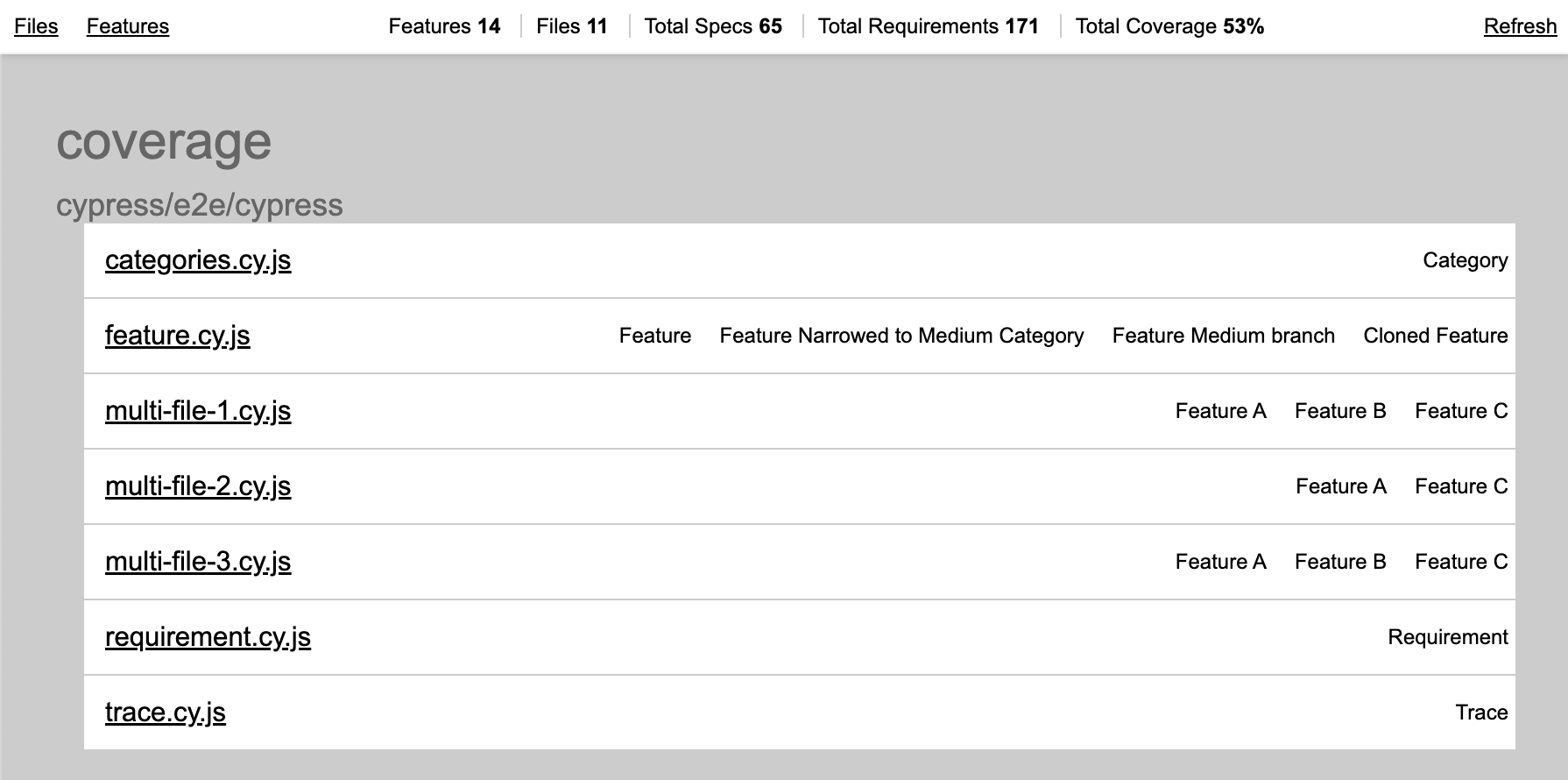
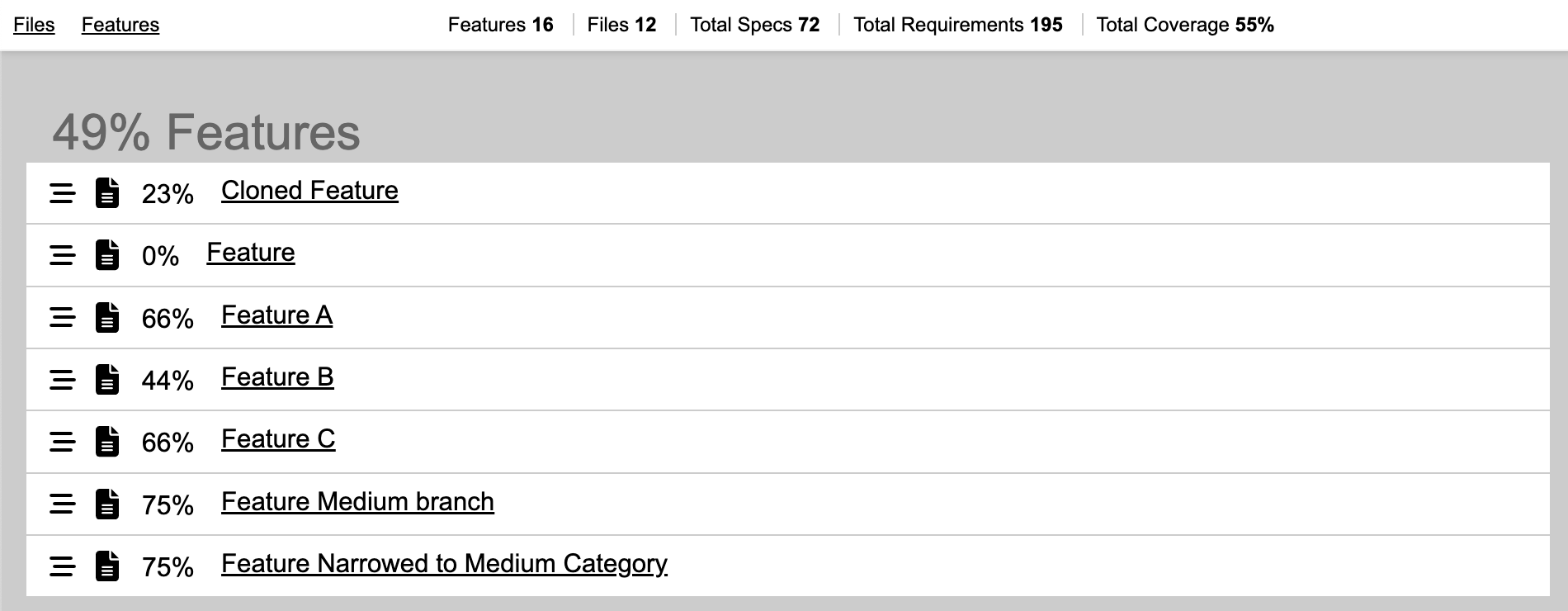

Examples of generated coverage reports can be viewed here for default coverage template and compact coverage template.
How it works
When creating E2E or integration tests engineers place special tracking commands using trace() function, it records which requirements of tested feature were covered and stores this information in JSON files as coverage. After tests run this coverage information can be viewed or used to generate HTML or LCOV coverage reports.
This is how trace usually look like, it accepts a name of the requirement or an array of strings which contains full category path to the requirement.
it("should do something according to requirement #1", () => {
// by requirement name
feature.trace("requirement #1");
// by full category path
feature.trace(["category", "sub category", "requirement #2"]);
expect(something).toEqual(somethingElse);
});The feature object used in the example above represents a specific feature that contains structure of its requirements. Feature object can be created in the test file, imported into test file or created by parsing a document of Markdown, YAML, XML, HTML or JSON format.
The file generated after test run is a JSON file and is not suitable for viewing, to generate viewable information and actual matrices/tables, user should use command traceability-matrices generate to generate static HTML files with reports or traceability-matrices serve to start local HTTP server with reports.
Example project is available in git repo
Installation
Install the package via NPM
npm install -D @actualwave/traceability-matricesor Yarn
yarn add -D @actualwave/traceability-matricesThen configure by defining an environment variable TRACE_RECORDS_DATA_DIR, this could be done in cypress config file
const { defineConfig } = require("cypress");
module.exports = defineConfig({
e2e: {
setupNodeEvents(on, config) {
// implement node event listeners here
},
env: {
// will store coverage reports in <feature-root>/cypress/coverage
TRACE_RECORDS_DATA_DIR: "cypress/coverage",
},
},
});Also, it might be useful to add commands to package.json
"scripts": {
"tm:serve": "traceability-matrices serve --target-dir=cypress/coverage",
"tm:generate": "traceability-matrices generate --target-dir=cypress/coverage --output-dir=coverage-static"
},calling npm run tm:serve will start local HTTP server with coveragereports and npm run tm:generate will generate HTML reports into coverage-static folder.
Commands
This package supports multiple commands to work with generated coverage reports after test run. All commands accept required parameter --target-dir which points at a coverage reports root folder, it is the same folder defined in TRACE_RECORDS_DATA_DIR environment variable. This parameter could be provided multiple times to point at multiple coverage directories to generate combined report.
traceability-matrices serve
Run HTTP/S server with coverage reports and open in default browser.
Parameters:
--target-dir- Required, path to directory with coverage reports--port- Port for HTTP/S server, 8477 by default--keyand--cert- Should point at private key and signed certificate files to start HTTPS server, by default starts HTTP server--compact- Optional, uses compact variant of HTML table, categories displayed as rows instead of columns. Default value is false. Might be preferable way of rendering features with deep structures.
Example:
traceability-matrices serve --target-dir=cypress/coverage --compact=true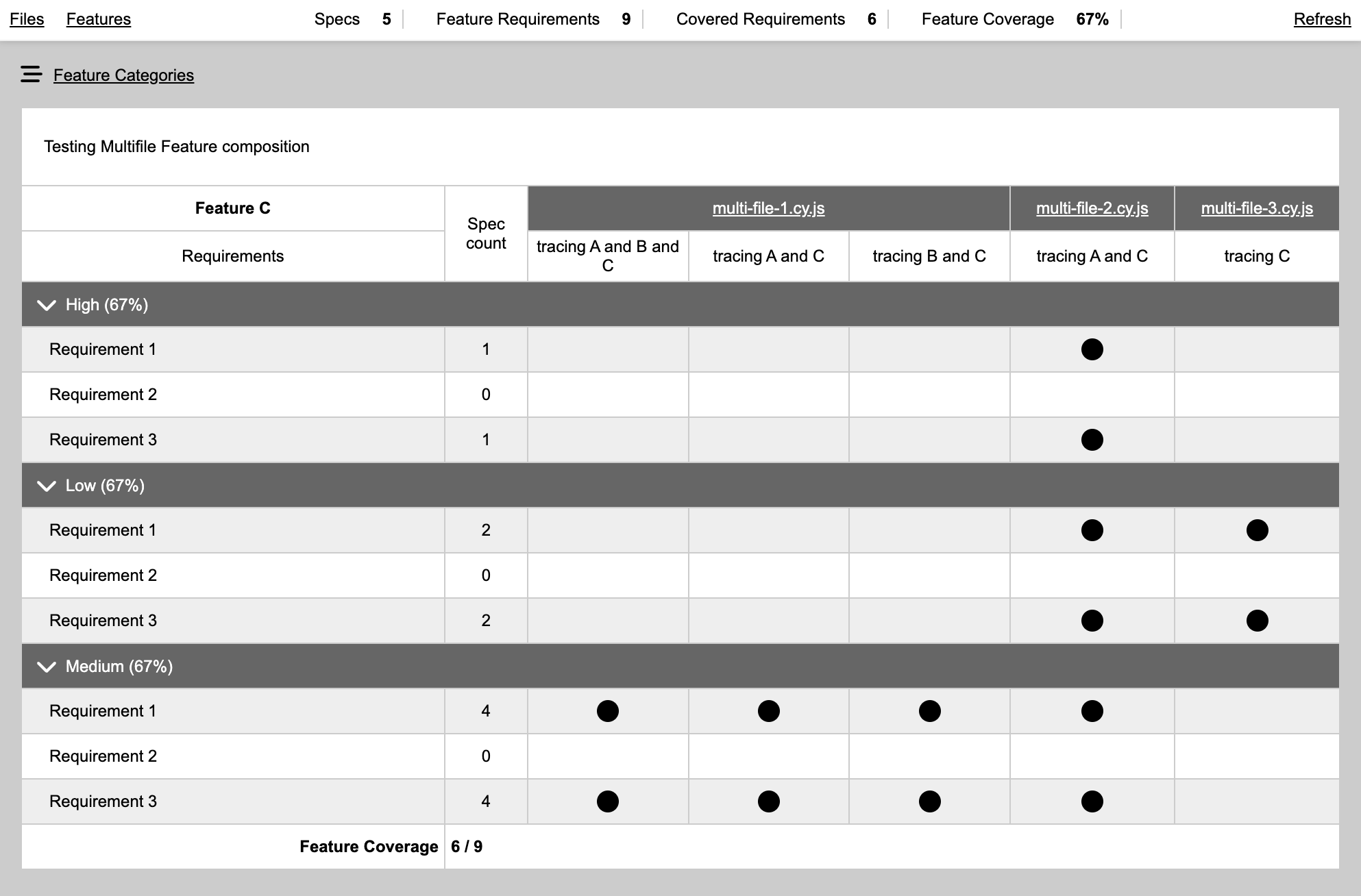
To run HTTPS server provide paths to key and certificate files relative to working directory
traceability-matrices serve --target-dir=coverage --output-dir=statics --compact=true --key=./key.pem --cert=./cert.pemtraceability-matrices generate
Generate static HTML files with coverage reports.
Parameters:
--target-dir- Required, path to directory with coverage reports.--output-dir- Required, path to folder where generated HTML files should be stored--compact=true- Optional, uses compact variant of HTML table, categories displayed as rows instead of columns. Default value is false. Might be preferable way of rendering features with deep structures.--force-cleanup=true- Will remove all contents of output folder before generating new content.
Example:
traceability-matrices generate --target-dir=cypress/coverage --output-dir=coverage-statictraceability-matrices threshold
Fails(exits with an error code) if coverage thresholds weren't met.
Parameters:
--target-dir- Required, path to directory with coverage reports.--total- Optional, defines global coverage threshold, value can be between 0 and 100. Fails command if combined coverage of all features does not meet threshold.--per-feature- Optional, defines coverage threshold applied to each feature, value can be between 0 and 100. Fails command if at least one feature does not meet threshold.
Example:
traceability-matrices threshold --target-dir=cypress/coverage --total=80 --per-feature=60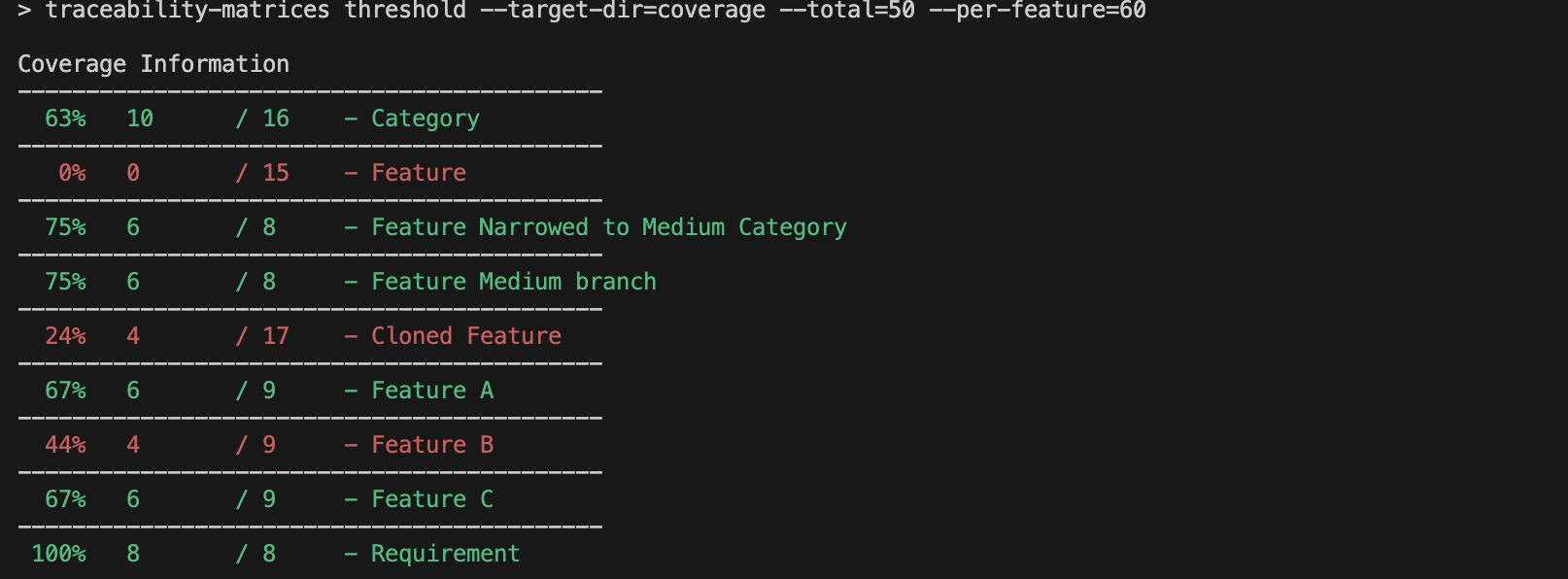
traceability-matrices stats
Outputs coverage information per feature with requirements.
Parameters:
--target-dir- Required, path to directory with coverage reports.
Example:
traceability-matrices stats --target-dir=cypress/coverage
traceability-matrices lcov
Generates a LCOV file with test coverage and file stricture with features information that can be used as source files which were targets for coverage. This can be used with any coverage reader or analyser tool like SonarQube.
Parameters:
--target-dir- Required, path to directory with coverage reports.--output-dir- Folder where to store LCOV coverage information and generated "source" files which can be used as a reference coverage reading tools.--relative-dir- Used to prepend file paths in coverage reports. By default recorded path to genrated sources will belcov/*.--force-cleanup=true- Will remove all contents of output folder before generating new content.
Example:
traceability-matrices lcov --target-dir=coverage --output-dir=generated_coverage_lcov --relative-dir=generated_coverage_lcovWith tools like SonarQube you can track the change of features coverage in time and setup thresholds.

File list in SonarQube does not show any useful information except coverage percentage because generated "source" 100% consists of comments.

Contents of the feature file, SonarQube shows uncovered requirements
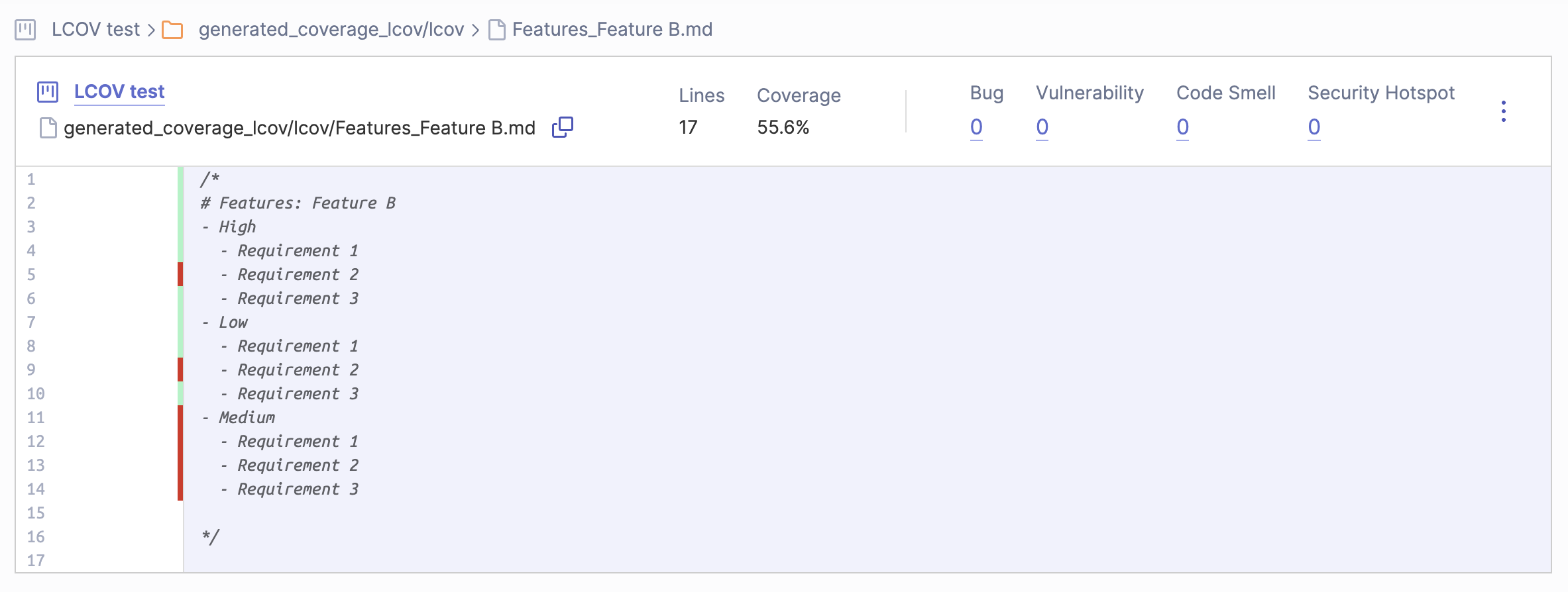
This SonarQube configuration required to configure it to read *.md files as JavaScript files to make it display coverage information for them.
traceability-matrices scan
Searches provided directories for supported feature files and creates report in target dir. Created report is a hidden coverage report with no coverage, this way all found features will be added to report even if they weren't used in tests.
Parameters:
--features-dir- Required, path to a directory with feature files, can be added multiple times if features stored in different folders. Sub-directories will also be scanned recursively.--target-dir- Required, path to a directory with coverage reports.
Example:
traceability-matrices scan --features-dir=./cypress/features --target-dir=coverageCypress integration
Cypresss integration starts with adding TRACE_RECORDS_DATA_DIR environment variable to cypress config that will tell where to store coverage reports
const { defineConfig } = require("cypress");
module.exports = defineConfig({
e2e: {
env: {
TRACE_RECORDS_DATA_DIR: "cypress/coverage",
},
},
});and defining a feature in a test file
import { createFeature } from "@actualwave/traceability-matrices/cypress";
const feature = createFeature({
title: "My Feature",
description: "This is a description of my new feature",
group: "Features",
});createFeature({ title: string, description?: string, group?: string }) accepts feature title and optionally description and group. Feature titles must be unique strings. Feature description could be an HTML string, it will display on top of feature coverage table and is suitable for placing various feature links and other useful information. Group will be used in a list of features to display features under same group and visually separate them from other.
import { createFeature } from "@actualwave/traceability-matrices/cypress";
const feature = createFeature({
title: "My Feature",
description: `
<h1>Useful information</h1>
<a href="https://react.dev/">Learn React</a>`,
group: "Features",
});Created feature provides methods to match test specs with feature requriements and genrates test records that will be stored in a JSON file once test run is finished.
feature.trace()
To match requirements with specs, traces should be placed within specs, like
// test spec
it("should do something according to requirement #1", () => {
// trace requirement
feature.trace("requirement #1");
expect(something).toEqual(somethingElse);
});Note: To properly match requirement string with feature structure requirement must be a unique string within its feature.
After running this test, coverage will contain a record that spec should do something according to requirement #1 tests requirement #1 requirement. One spec may contain multiple requriements and traces could contain expectations or be nested.
it("should do something according to multiple requirements", () => {
feature.trace("requirement #1", () => {
expect(something).toEqual(somethingElse);
feature.trace("requirement #3", () => {
expect(something).toEqual(somethingElse);
feature.trace("requirement #4", () => {
expect(something).toEqual(somethingElse);
});
});
});
feature.trace("requirement #2");
expect(something).toEqual(somethingElse);
});feature.trace() could be used to generate requirements tree by providing an array of strings
it("should do something according to requirement #1", () => {
feature.trace(["High", "General", "PRD I", "requirement #1"]);
feature.trace(["High", "General", "PRD I", "requirement #2"]);
feature.trace(["High", "General", "PRD I", "requirement #3"]);
feature.trace(["Low", "PRD IVa", "requirement #45"]);
feature.trace(["Low", "PRD IVa", "requirement #46"]);
feature.trace(["optional requirement #1"]);
expect(something).toEqual(somethingElse);
});This will generate a structure of requirements
- High
- General
- PRD I
- requirement #1
- requirement #2
- requirement #3
- PRD I
- General
- Low
- PRD IVa
- requirement #45
- requirement #46
- PRD IVa
- optional requirement #1
Such structure also could be created using feature.structure() method
feature.structure({
High: {
General: {
"PRD I": {
"requirement #1": {},
"requirement #2": {},
"requirement #3": {},
},
},
},
Low: {
"PRD IVa": {
"requirement #45": {},
"requirement #46": {},
},
},
"optional requirement #1": {},
});and with this just use requirement name in feature.trace() call,
it("should do something according to requirement #1", () => {
feature.trace("requirement #3");
expect(something).toEqual(somethingElse);
});it will be matched to a leaf node of the structure. If requirement could not be found in the structure, it will be added to the root of the structure when coverage is generated.
Without structure containing all feature requirements, the feature will have 100% coverage because there will be only requirements added from traces placed in specs(which are already marked as covered). Having structure with all feature requirements allows proper coverage calculation. For coverage calculation it does not matter(purely visual benefit) if structure is flat or organised into categories.
Note: Categories(branches, not leaf nodes) in such structure could contain HTML markup. Using HTML markup in requirement string is also possible, it will be properly rendered but might be uncomfortable to use in test specs.
feature.requirement()
With feature.trace(), engineer could use feature.requirement() and specify requirement to use in multiple places.
const req1 = feature.requirement("requirement #1");Once created, it could be used to replace test lifecycle hooks like describe() and it()
req1.describe('When someting', () => {
...
});
req1.it('should do', () => {
...
});Both will record requirement being tested in these places.
feature.category()
category() method allows to specify category path for traced requirements. It returns an object with category(), trace() and requirement() functions. If feature contains identical requirement in multiple places using trace() from specific category helps to locate exact requirement.
For example, if we have this structure
{
"Requirement 1": null,
"Requirement 2": null,
"Category 1": {
"Requirement 1": null,
"Requirement 2": null,
},
"Category 2": {
"Requirement 1": null,
"Requirement 2": null,
},
}Tracing requirement Requirement 1 from a future level will lookup for a first requirement occurance, so all traces will be recorded on Requirement 1 in a root category.
it("should trace requirement 1 from category 2", () => {
feature.trace("Requirement 1");
});Using trace() from a specific category helps to point at requirement on its level.
const category1 = feature.category("Category 2");
it("should trace requirement 1 from category 2", () => {
category1.trace("Requirement 1");
});This will trace Requirement 1 from Category 2.
This function can be used multiple times and it accepts multiple categories for deeply nested requirements.
const child = feature.category("Parent Category", "Child Category");These two examples are equivalent.
const parent = feature.category("Parent Category");
const child = parent.category("Child Category");feature.setTraceToRequirementMatcher()
In some cases it might be not comfortable to put whole requirement text into traces in test files. Using this function requirements can be looked up using unique identifiers. It accepts a custom function that will be called with traced string and a strucutre object, its purpose to identify and return requirement text or a path array [category, ..., requirement] that points at specific requirement in a structure.
import {
createFeature,
readStructureRequirements,
} from "@actualwave/traceability-matrices/cypress";
const Feature = createFeature({
title: "Requirement matcher",
group: "Features",
});
Feature.structure(
{
High: {
"HR-1 Requirement text is so long that might be difficult to use in tests.":
null,
"HR-2 Requirement text is so long that might be difficult to use in tests.":
null,
"HR-3 Requirement text is so long that might be difficult to use in tests.":
null,
},
"RR-1 Requirement text is so long that might be difficult to use in tests.":
null,
"RR-2 Requirement text is so long that might be difficult to use in tests.":
null,
"RR-3 Requirement text is so long that might be difficult to use in tests.":
null,
},
["Category", "Requirement"]
);
Feature.setTraceToRequirementMatcher(({
name,
structure
}) => {
if (name instanceof Array) {
return name;
}
/*
* readStructureRequirements() reads structure and returns all requirements in a form of 2-dimensional array
* [
* [requirement, path]
* ]
*
* where
* requirement - requirement text
* path - an array or strings that identifies requirement in a structure
*/
const reqs = readStructureRequirements(structure);
const [, path] = reqs.find(([key]) => key.startsWith(name));
return path || name;
});
describe("Matcher", () => {
describe("High category requirements", () => {
it("trace second requirement", () => {
/*
* this trace will use matcher to identify requirement using inuque identifier
* matcher will result with
* [
* "High",
* "HR-2 Requirement text is so long that might be difficult to use in tests."
* ]
*/
Feature.trace("HR-2");
});
});
});category() allows setting custom matcher for its requirements and sub-category requirements.
const RootCategory = feature.category("Root Category");
RootCategory.setTraceToRequirementMatcher(findRootCategoryRequirement);
const ChildCategory = feature.category("Root Category", "Child Category");
ChildCategory.setTraceToRequirementMatcher(findChildCategoryRequirement);
const DescendantCategory = ChildCategory.category("Descendant Category");
DescendantCategory.setTraceToRequirementMatcher(
findDescendantCategoryRequirement
);Removing a matcher(by setting to
undefined) will revert to using parent category or feature matcher if set.
When setting matcher to a category, it is not being assigned to a category by its path, but into objects internal state.
So, when called category() on same category next time returned object will not have the same matcher.
const ChildCategory1 = feature.category("Root Category", "Child Category");
// setting matcher to ChildCategory1
ChildCategory1.setTraceToRequirementMatcher(findChildCategoryRequirement);
// it does not have the matcher previously set to same category but different object,
// you have to set it again for ChildCategory2 to make it work for this object
const ChildCategory2 = feature.category("Root Category", "Child Category");
// now it also has the matcher
ChildCategory2.setTraceToRequirementMatcher(findChildCategoryRequirement);feature.structure()
feature.structure() used to specify category tree, and it should be built only with objects. Leaf objects of this structure will be identified as a testable requirements, other branches are categories and could not be tested.
feature.structure({
High: {
General: {
"PRD I": {
"requirement #1": {},
"requirement #2": {},
"requirement #3": {},
},
},
},
});With structure tree optionally list of table headers could be provided, they will be used to render HTML table in the report
feature.structure(
{
High: {
General: {
"PRD I": {
"requirement #1": {},
"requirement #2": {},
"requirement #3": {},
},
},
},
},
["Priority", "Category", "Requirement"]
);If test will contain a trace to category, that record will be added as a leaf node to the root of the structure.
feature.structure() return an object with additional methods to work with structure.
add(...path: string[]) => Record<string, object>- add categories/requirements to the structure if not existget(...path: string[]) => Record<string, object>- retrieve a branch of the structuremerge(source: Record<string, object>) => void- merge external structure intoclone(...path: string[]) => Record<string, object>- clone and return whole or branch of the structurebranch(path: string[], featureTitle: string, featureDescription?: string) => FeatureApi- create a sub-feature from structure branch. sub-feature will have no connection to current feature and structures will be copied.narrow(path: string[], featureTitle: string, featureDescription?: string) => FeatureApi- create sub-feature with a structure by removing branches out of provided path. sub-feature will have no connection to current feature and structures will be copied.
feature.headers()
Allows to specify list of HTML table headers. In compact mode only last header is used.
feature.clone()
Clone feature, creates a new feature with same structure and empty test records.
feature.valueOf()
Returns internal state of the feature
Parsers
This project includes parsers that allow reading feature information from various file types. All of them return feature API object and work in a same way, just like object returned from createFeature().
Markdown
Markdown file structure should start with 1st level header which will be parsed as a feature title. If title has a slash in it, it will be split into group and title.
# Feature Group / Feature Title
This is the text of feature description, may contain images, links etc.Any text without below title is used as a feature description. Structure of the feature marked with lower level headers and lists.
- Requirement 1
# Category
- Requirement 2
## Sub Category
- Requirement 3Converts into feature struture:
- Requirement 1
- Category
- Requirement 2
- Sub Category
- Requirement 3
Same structure can be described with headers only
# Requirement 1
# Category
## Requirement 2
## Sub Category
### Requirement 3Or lists only
- Requirement 1
- Category
- Requirement 2
- Sub Category
- Requirement 3Category defined by availability of lower level headers or lists below it.
# This is a category
## Because this lower level header existsIf header has no lower level headers below, it will be parsed as a requirement.
# This is not a category because there are no lower level headers or lists under it
# Category
## RequirementAny text under the header will be merged with requirement or category text.
# Category
More text with some details about this category
## RequirementFeature example
# Parsers / Feature Markdown
My feature description with [HTML](https://google.com)
## High
- High Requirement 1
- High Requirement 2
- High Requirement 3Usage in cypress test
import { createFeatureFromMarkdownAsync } from "@actualwave/traceability-matrices/markdown";
const Feature = createFeatureFromMarkdownAsync(
"cypress/features/ParserMarkdown.md"
);
describe("Markdown", () => {
describe("High requirements", () => {
it("trace high requirements", () => {
Feature.trace("High Requirement 2");
});
});
});YAML
YAML should have these properties on the root level
title: string- Feature name, required.structure: object- Feature structure, required.description: string- Feature description, optional. May contain HTML tags.group: string- Feature group, optional. Structure object should contain feature requirements. Requirement field may have any primitive or an empty object as a value. It may also contain arrays or other objects with fields, these will be treated as categories.
structure:
Requirement 1: null
Category:
Requirement 2:
Sub Category:
- Requirement 3Structure cannot have empty categories -- empty objects will be parsed as requirements.
Feature example:
title: Feature Yaml
description: My feature description with <a href=\"https://google.com\">HTML</a>
group: Parsers
structure:
High:
- High Requirement 1
- High Requirement 2
- High Requirement 3Usage in cypress test
import { createFeatureFromYamlAsync } from "@actualwave/traceability-matrices/yaml";
const Feature = createFeatureFromYamlAsync("cypress/features/ParserYaml.yaml");
describe("YAML", () => {
describe("High requirements", () => {
it("trace high requirements", () => {
Feature.trace("High Requirement 2");
});
});
});XML
XML file structure starts with a root tag feature. It should contain these tags
title- Feature title, required.structure- Feature structure, required.description- Feature description, optional.group- Feature group, optional.
Value is the text content and child nodes, tag attributes are ignored.
Structure is described with two tags category for categories and requirement for requirements. Category tag should contain a name tag that will contain category name and requirment tags to specify this category requirements, it may also contain other category tags for sub-categories.
<structure>
<requirement>Requirement 1</requirement>
<catgegory>
<name>Category</name>
<requirement>Requirement 2</requirement>
<catgegory>
<name>Sub Category</name>
<requirement>Requirement 3</requirement>
</category>
</category>
</structure>Structure cannot contain empty categories, they will be converted into requirements.
Feature example:
<feature>
<title>Feature Xml</title>
<description
>My feature description with
<a href="https://google.com">HTML</a></description
>
<group>Parsers</group>
<category>
<name>High</name>
<requirement>High Requirement 1</requirement>
<requirement>High Requirement 2</requirement>
<requirement>High Requirement 3</requirement>
</category>
</feature>Usage in cypress test
import { createFeatureFromXmlAsync } from "@actualwave/traceability-matrices/xml";
const Feature = createFeatureFromXmlAsync("cypress/features/ParserXml.xml");
describe("XML", () => {
describe("High requirements", () => {
it("trace high requirements", () => {
Feature.trace("High Requirement 1");
Feature.trace("High Requirement 2");
// using full path
Feature.trace(["High", "High Requirement 3"]);
});
});
});HTML
HTML praser uses data- attributes to find feature-related information and may have any kind of tags. Tags without proper data-attributes are ignored.
Supported attributes
data-feature-title- Feature title, should have valuedata-feature-group- Feature group, shold have value and must be plaved on same element as title attribute.data-feature-description- Feature description. If no value defined as a description will be taked HTML content of the element.data-feature-requirement- Structure requirement, will be added to feature structure. If element with this attribute placed into category element, requirement will be added to corresponding category. Should define requirement name in the attribute value.data-feature-category- Structure category, all requirements defined in descendants of this category element will also be descendants of this category in feature structure. Structure will repeat the structure of HTML tree ignoring all elements not containig category or requirement attributes. Should define category name in the attribute value.
HTML feature example
<!DOCTYPE html>
<html>
<head>
<title>HTML Feature Document</title>
</head>
<body>
<h1 data-feature-title="Feature Html" data-feature-group="Parsers">
Feature HTML
</h1>
<strong data-feature-description
>My feature description with <a href="https://google.com">HTML</a></strong
>
<h4>Structure</h4>
<span data-feature-requirement="Requirement 1"
>Some freature requirement</span
>
<strong>Structure Category</strong>
<ul data-feature-category="Category">
<li data-feature-requirement="Requirement 2">Requirement 2</li>
<li data-feature-category="Sub category">
<strong>Sub category structure</strong>
<ul>
<li data-feature-requirement="Requirement 3">
Sub category Requirement 3
</li>
</ul>
</li>
</ul>
</body>
</html>Usage in cypress test
import { createFeatureFromHtmlAsync } from "@actualwave/traceability-matrices/html";
const Feature = createFeatureFromHtmlAsync("cypress/features/ParserHtml.html");
describe("HTML", () => {
describe("Category requirements", () => {
it("trace category requirements", () => {
Feature.trace("Requirement 2");
// using full path
Feature.trace(["Category", "Sub category", "Requirement 3"]);
});
});
});JSON
JSON file structure should have these properties on the root level
title: string- Feature name, required.structure: object- Feature structure, required.description: string- Feature description, optional. May contain HTML tags.group: string- Feature group, optional. Structure object should contain feature requirements. Requirement field may have any primitive or an empty object as a value. It may also contain other objects with fields, these will be treated as categories.
"structure": {
"Requirement 1": null,
"Category": {
"Requirement 2": "",
"Sub Category": {
"Requirement 3": {},
}
}
}Structure cannot have empty categories -- empty objects will be parsed as requirements.
Feature example:
{
"title": "Feature Json",
"description": "My feature description with <a href=\"https://google.com\">HTML</a>",
"group": "Parsers",
"structure": {
"High": {
"High Requirement 1": {},
"High Requirement 2": {},
"High Requirement 3": {}
}
}
}Usage in cypress test
import { createFeatureFromJsonAsync } from "@actualwave/traceability-matrices/json";
const Feature = createFeatureFromJsonAsync("cypress/features/ParserJson.json");
describe("JSON", () => {
describe("High requirements", () => {
it("trace high requirements", () => {
Feature.trace("High Requirement 1");
Feature.trace("High Requirement 2");
// using full path
Feature.trace(["High", "High Requirement 3"]);
});
});
});Links
For latest version of reporting UI I've used couple free FontAwesome icons.
1 year ago
1 year ago
1 year ago
1 year ago
2 years ago
2 years ago
2 years ago
2 years ago
2 years ago
2 years ago
2 years ago
2 years ago
2 years ago
2 years ago
2 years ago
2 years ago
2 years ago
2 years ago
2 years ago
2 years ago
2 years ago
2 years ago
2 years ago
2 years ago
2 years ago
2 years ago
2 years ago
2 years ago
2 years ago
2 years ago